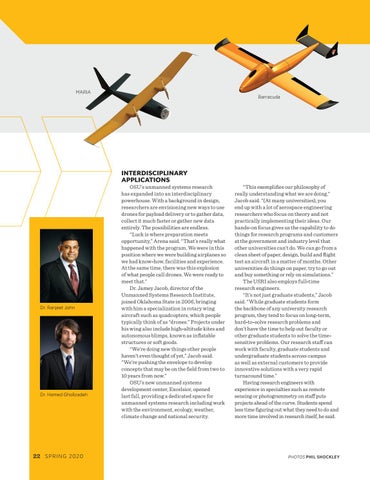MARIA
Barracuda
INTERDISCIPLINARY APPLICATIONS
Dr. Ranjeet John
Dr. Hamed Gholizadeh
22 S P R I N G 2 0 2 0
OSU’s unmanned systems research has expanded into an interdisciplinary powerhouse. With a background in design, researchers are envisioning new ways to use drones for payload delivery or to gather data, collect it much faster or gather new data entirely. The possibilities are endless. “Luck is where preparation meets opportunity,” Arena said. “That’s really what happened with the program. We were in this position where we were building airplanes so we had know-how, facilities and experience. At the same time, there was this explosion of what people call drones. We were ready to meet that.” Dr. Jamey Jacob, director of the Unmanned Systems Research Institute, joined Oklahoma State in 2006, bringing with him a specialization in rotary wing aircraft such as quadcopters, which people typically think of as “drones.” Projects under his wing also include high-altitude kites and autonomous blimps, known as inflatable structures or soft goods. “We’re doing new things other people haven’t even thought of yet,” Jacob said. “We’re pushing the envelope to develop concepts that may be on the field from two to 10 years from now.” OSU’s new unmanned systems development center, Excelsior, opened last fall, providing a dedicated space for unmanned systems research including work with the environment, ecology, weather, climate change and national security.
“This exemplifies our philosophy of really understanding what we are doing,” Jacob said. “(At many universities), you end up with a lot of aerospace engineering researchers who focus on theory and not practically implementing their ideas. Our hands-on focus gives us the capability to do things for research programs and customers at the government and industry level that other universities can’t do. We can go from a clean sheet of paper, design, build and flight test an aircraft in a matter of months. Other universities do things on paper, try to go out and buy something or rely on simulations.” The USRI also employs full-time research engineers. “It’s not just graduate students,” Jacob said. “While graduate students form the backbone of any university research program, they tend to focus on long-term, hard-to-solve research problems and don’t have the time to help out faculty or other graduate students to solve the timesensitive problems. Our research staff can work with faculty, graduate students and undergraduate students across campus as well as external customers to provide innovative solutions with a very rapid turnaround time.” Having research engineers with experience in specialties such as remote sensing or photogrammetry on staff puts projects ahead of the curve. Students spend less time figuring out what they need to do and more time involved in research itself, he said.
PHOTOS PHIL SHOCKLEY
